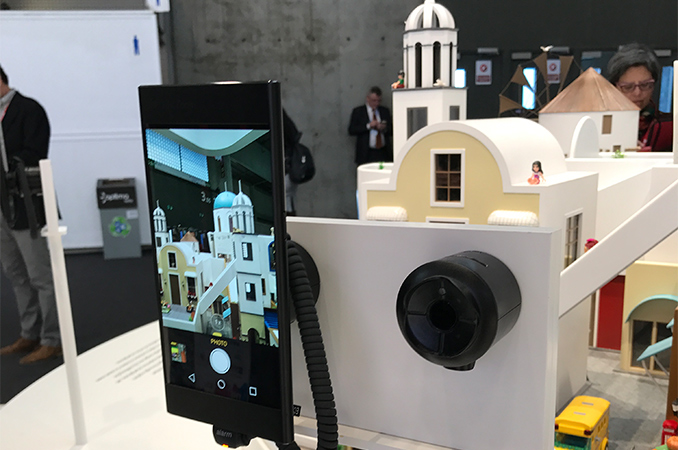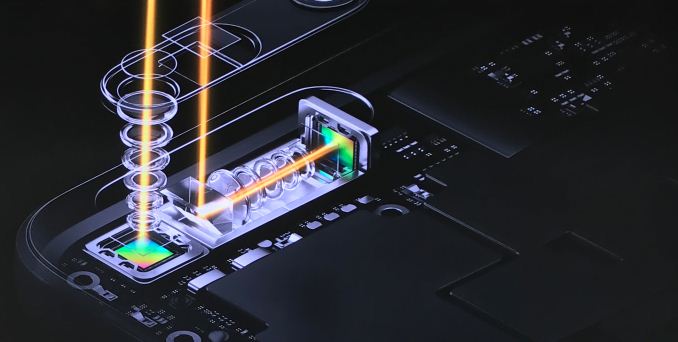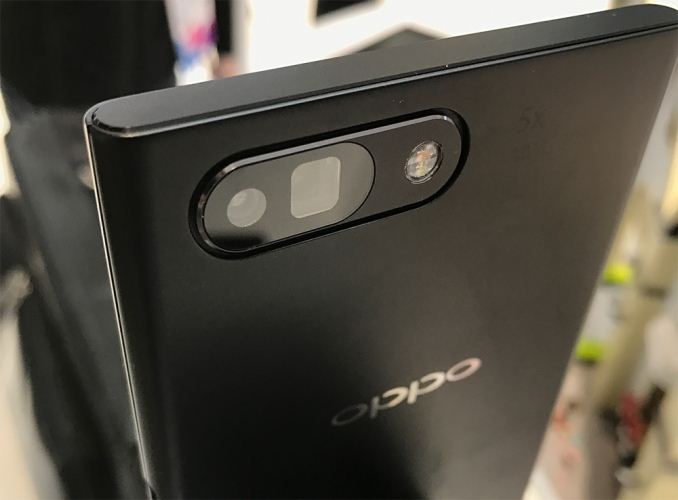MWC 2017: Oppo Demonstrates 5X Optical Zoom for Smartphones
by Anton Shilov on March 13, 2017 10:00 AM EST- Posted in
- Smartphones
- Android
- Trade Shows
- MWC_2017
- Oppo
- Optical Zoom

This year at MWC, Oppo showed off a smartphone prototype that used a new implementation of dual cameras to offer a 5X optical zoom. The company did not reveal anything about the actual plans to use it for products, nor did they reveal the cost of its implementation, but it is likely that it will reach the market sometimes in the future.
Imaging capabilities of smartphones have been evolving rapidly since the introduction of the first handsets with cameras. Throughout the history of phones making photos, manufacturers have developed new lens packs, new CMOS sensors and extensive ISPs (image sensor processors) in order to improve the capability and/or quality of images. For a while, a number of makers tended to install higher-resolution sensors simply because the 'megapixel number' was easier to explain than the quality of optics or advanced ISPs. A lot has changed in the recent years as various smartphone makers have invested in high-end lenses (co-developed with Carl Zeiss, Leica, etc.), developed their own SoCs/ISPs for image processing, and other potential differentiators in a cramped smartphone ecosystem.
So at MWC 2017, multiple smartphone manufacturers demonstrated their products with dual back-facing sensors (RGB+RGB or RGB+IR) to further improve their photography acumen. One of those was Oppo using the two sensors to build a portable camera system with a 5X optical zoom in a very different configuration to what we have seen before.
Optical zoom is not anything new for smartphones, but Oppo’s approach is a little bit different compared to that used by other makers. The 5X dual camera optical zoom from Oppo relies on two image sensors:
- The first is placed inline with the motherboard (just like sensors inside all smartphones) and is equipped with a regular lens pack such that the light hits the sensor with minimal adjustment.
- The second is placed perpendicularly to the motherboard and is equipped with other optics with image stabilization and optical zoom. It is possible that the lens system here can physically move to allow for extra enhancement.
To direct the light to the second sensor, Oppo uses a special prism mirror placed perpendicularly to the motherboard (so, basically, everything works like a periscope) and which it can precisely regulate angles as low as 0.0025 degrees to compensate shaking. To enable 5X optical zoom, an unknown ISP processes images from both sensors.
In its booth at the MWC 2017, Oppo demonstrated promo videos describing the added qualities of its optical zoom capabilities, as well as its optical image stabilization. In addition, the company allowed visitors to try out the prototype devices. One of the concerns, when you use mirrors to transfer light, is that luminous intensity drops as well as a drop in the quality of images. In its video at the trade show, Oppo showcased that the quality of the photos made using the prototype featuring its 5X dual camera optical zoom in dark conditions was better when compared to images made by an 'unknown' rival. With a minor hands-on, we noticed no immediate problems shooting the images in light conditions. There are other phones with prisms used in the market it should be noted, however not quite used in this way.
Oppo did not mention which smartphones are going to use its 5X dual camera optical zoom technology, nor did it mention when. The reference system on the show floor looks slim, so it could be installed into various handsets by Oppo and give the company an opportunity to use it for its top-of-the-range smartphones with large displays, or perhaps for smaller models as well (provided that they have appropriate SoCs/ISPs).
It is noteworthy that in its briefing materials, Oppo did not state the type of sensors in use, but solely emphasized only the 5X dual cam optical zoom. This may likely be a work in progress for a future device, which may or may not be a smartphone.














23 Comments
View All Comments
plopke - Monday, March 13, 2017 - link
I do not take a lot of pictures on my phone and never been a argument for me to by a smartphone but damm the evolution of mobile photography over the last 20 years.philehidiot - Monday, March 13, 2017 - link
I have a DSLR and my phone and nothing in between. In some situations my DSLR fails me completely (or, more likely, my skill level fails to impress it and so it churns out crap) and my phone (being newer with HDR) produces the better photograph. Best thing about a good phone camera is it's always with you, followed by the advantage of actually having your photos with you all the time. Take them on a proper camera and they're on your PC, you never sit and sort through them properly and always end up with loads that you never look at because well... flash memory, why not have it on continuous shooting followed by I can't be bothered to sort through 200 photos of my dog just now. Add infinitum (or until photos > free HDD space).Take them with a phone and you have to consider it more due to the limitations of the device, space must be considered and so you end up sorting as you go, often enhancing on the phone and you have them to hand if you want to show someone something. I also find the search function in Google Photos pretty damned useful - if someone expresses a desire to go somewhere on holiday, instead of ploughing through 2000 photos to find the ones from your trip, you can search "Barcelona" and it'll bring them all up immediately. And I just can't extol the virtues enough of being able to post a photo of your breakfast onto Facebook instantly whilst "tagging" everyone you know in it to ensure they all receive a notification and so they definitely see that which you're going to crap out in a few hours time. Showing them a photo of the end result is also important to ensure they're fully informed of the complete cycle of your food consumption.
There is a big downside however in that the extra you spend on a flagship phone with a decent camera every couple of years is way more than you'd spend on an Android phone with a mediocre camera but is perfectly functional in nearly every other way. It's also more than you'd spend on a compact camera which would probably last 5+ years and you're spending that every 2. For a way more limited camera. I personally think that decent cameras with decent post processing will remain the remit of flagship devices as it's one of the few ways they can continue to get people to pay the 50% premium for the top of the range phone.
dullard - Monday, March 13, 2017 - link
1) If your phone takes better photos than your DSLR, then as you admit yourself, the problem is you.2) While it isn't quite as convenient, you can buy cameras with Wi-Fi or even SD cards with Wi-Fi built in. Take a great shot with your real camera, send it to your phone, put it on Facebook or whatever you want. Sure it is one more step, but it isn't very difficult.
3) Or you can get one of many phones still with micro SD card slots. Take a great photo on a real camera, move the micro SD card over, upload.
I use three cameras regularly. A phone when I don't care about quality. A small pocketable camera when I want a great shot but don't want to carry my phone or DSLR (such as hiking through the rain to a mountain top). And a DSLR to take great photos. Even with flagship smartphones, the photo quality pales in comparison to a real camera.
philehidiot - Monday, March 13, 2017 - link
Yeh you make perfectly decent points. I would add that the times when I get a better shot with the phone is when it can employ HDR whereas my DSLR is very old (6MP by konika minolta who don't even make cameras anymore - not exactly rocking the modern stuff). And yes, the problem is me - I'm not as good as I'd like to be at it, well pointed out. And my DSLR also uses CF and doesn't have WiFi or anything else. These days I struggle to afford to replace the telephoto lens that has broken (gears gone, won't focus) so I sure as hell can't afford a new DSLR body with all the trimmings. If you'd like to buy me one, feel free. Sony if you don't mind as I've got a really nice 50mm prime lens I'd rather like to keep using.Phone budget is different and serves a different purpose which as I've pointed out above is more useful to me than the DSLR.
lmcd - Tuesday, March 14, 2017 - link
I don't know if 6MP by Konika Minolta counts as a relevant datapoint.Rοb - Sunday, September 3, 2017 - link
> "And my DSLR also uses CF and doesn't have WiFi or anything else.".He is suggesting to buy a Memory Card with WiFi built-in, it transfers to your Phone automatically which can then upload your Photos: https://www.cnet.com/how-to/how-to-add-wi-fi-to-yo... .
A new Phone can also provide excellent results, the HTC U11 scores 90 on DxOMark. With 3rd Party Lenses you can also get 'snap-on lens quality and variety'.
The Oppo with 5x Optical Zoom interests me, as this is about all that's missing from Cellphones (unless you want a 2000mm Lens, but there are Adapters for that).
darkich - Tuesday, March 14, 2017 - link
Damn what a comment..:)funkforce - Monday, March 13, 2017 - link
God! I cant stop laughing!"And I just can't extol the virtues enough of being able to post a photo of your breakfast onto Facebook instantly whilst "tagging" everyone you know in it to ensure they all receive a notification and so they definitely see that which you're going to crap out in a few hours time. Showing them a photo of the end result is also important to ensure they're fully informed of the complete cycle of your food consumption."
*crying from laughing*
This was the funniest shit in a long time, pun intended. You are a wicked genius!
philehidiot - Monday, March 13, 2017 - link
Thanks, however I can only credit my British upbringing and therefore instinctive urge to leap on any opportunity for toilet humour.darkich - Tuesday, March 14, 2017 - link
Damn what a comment:)